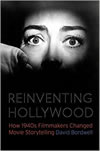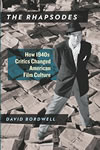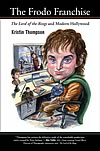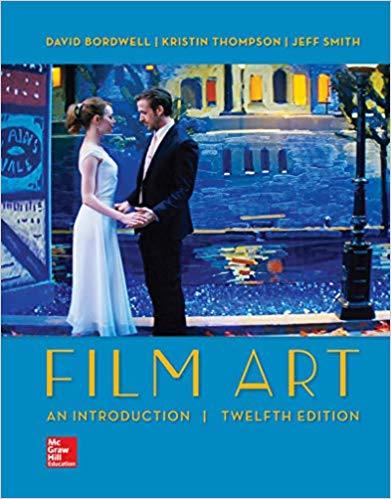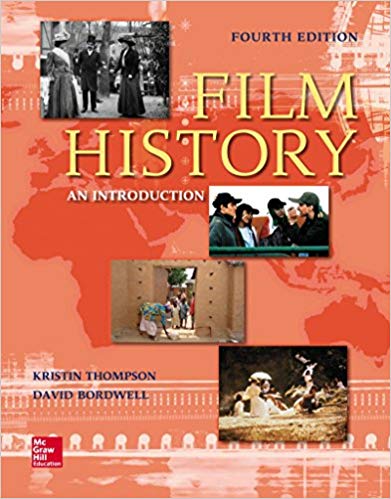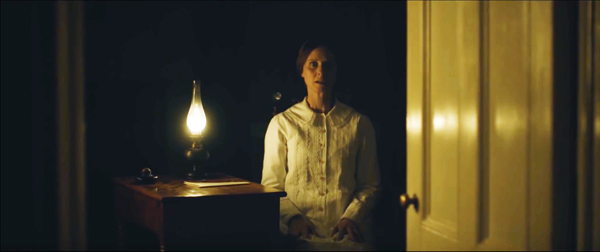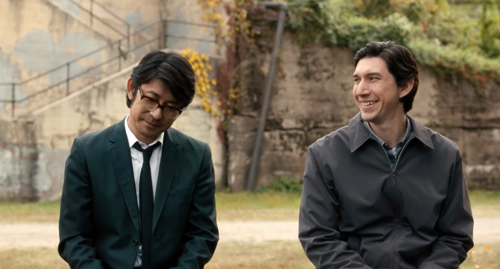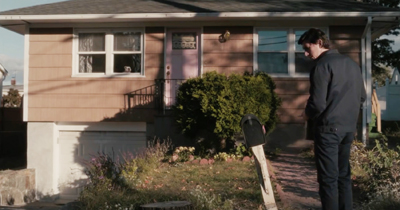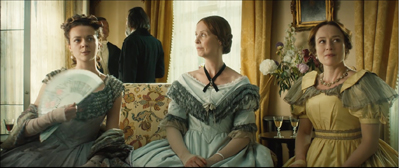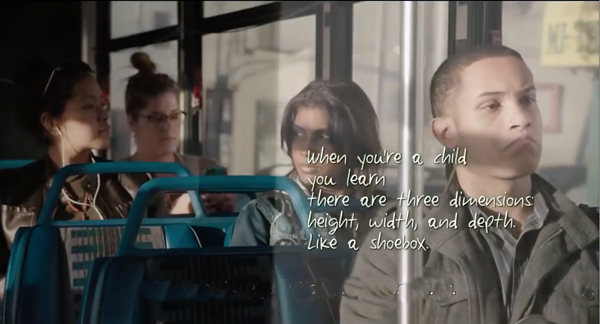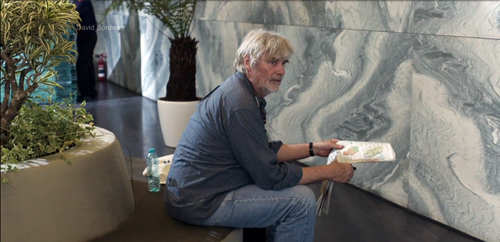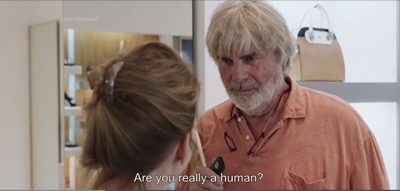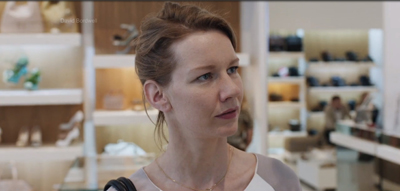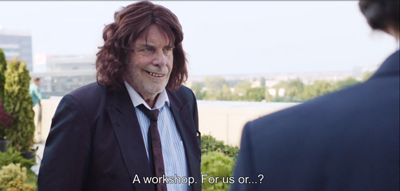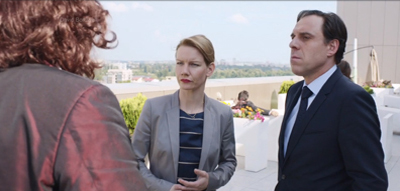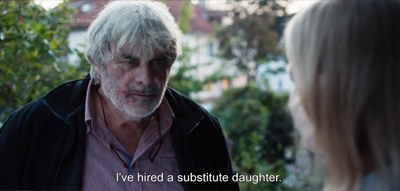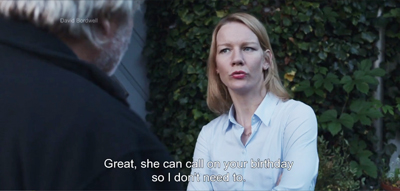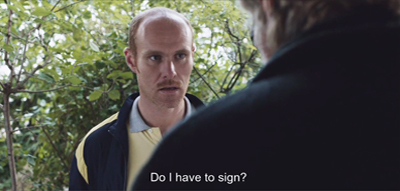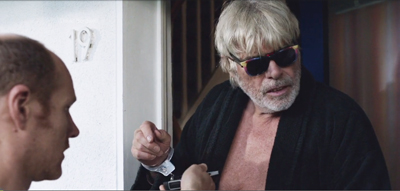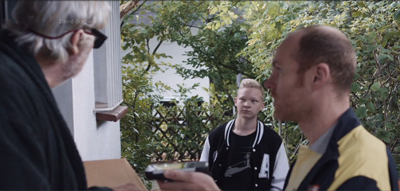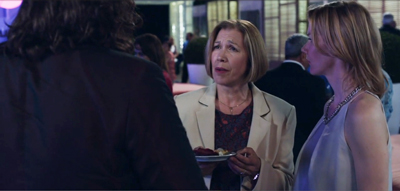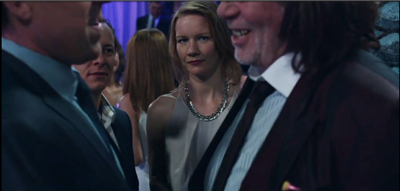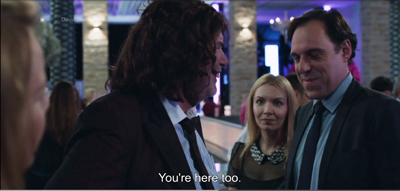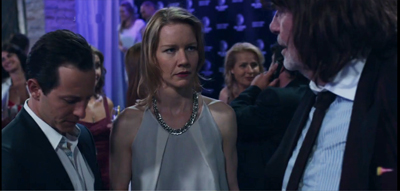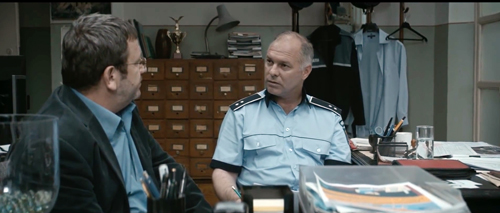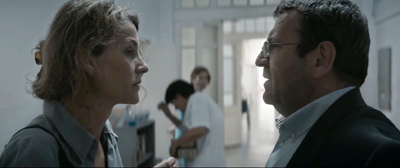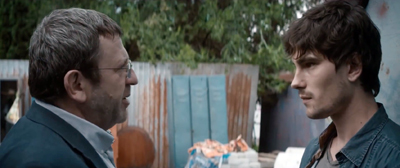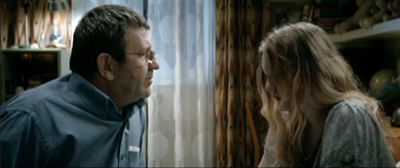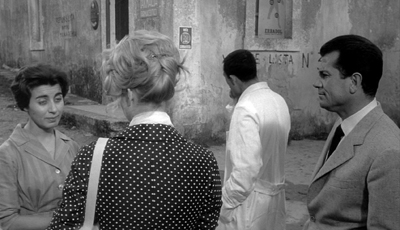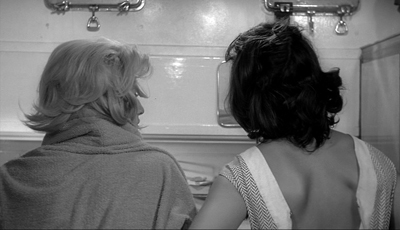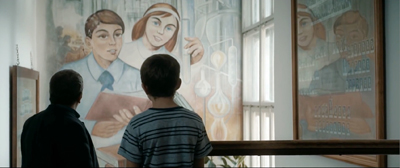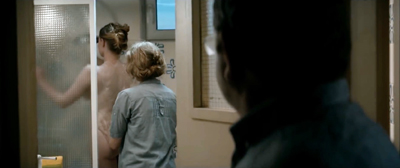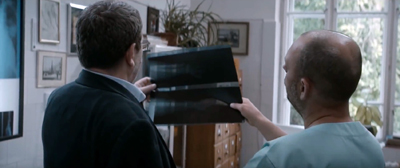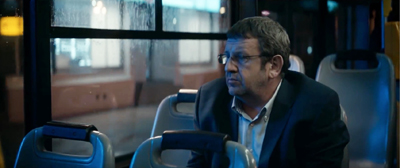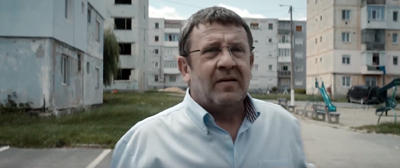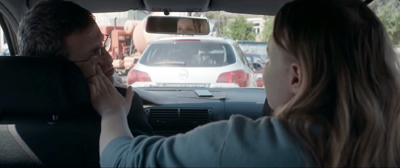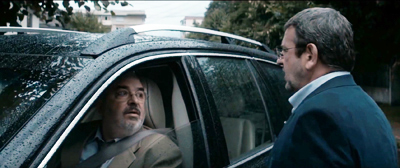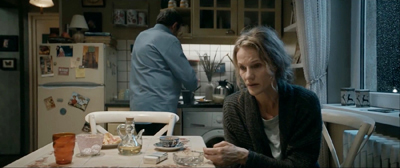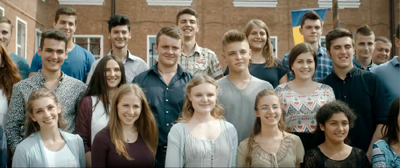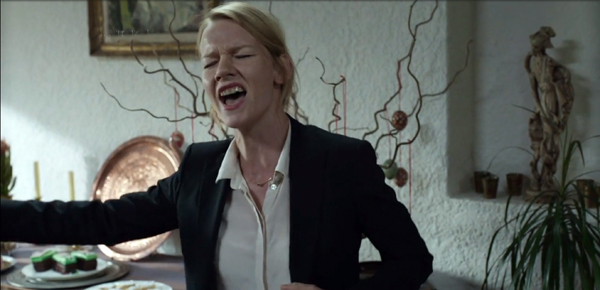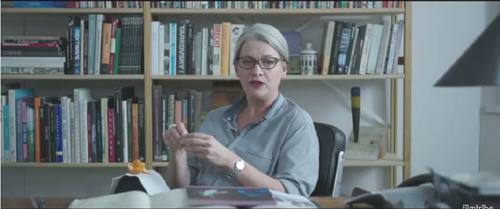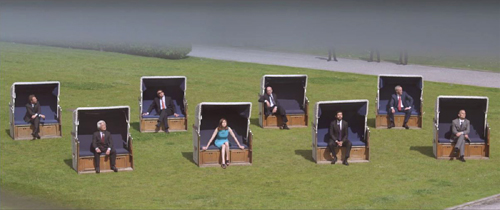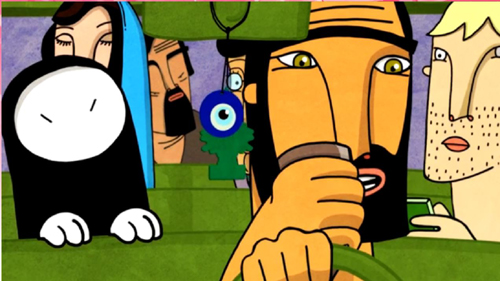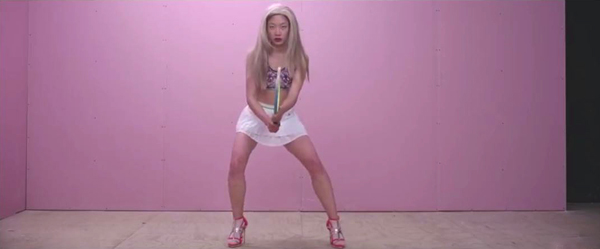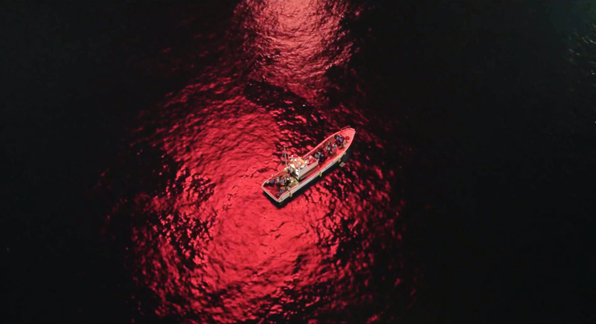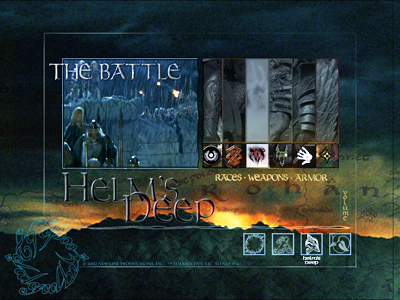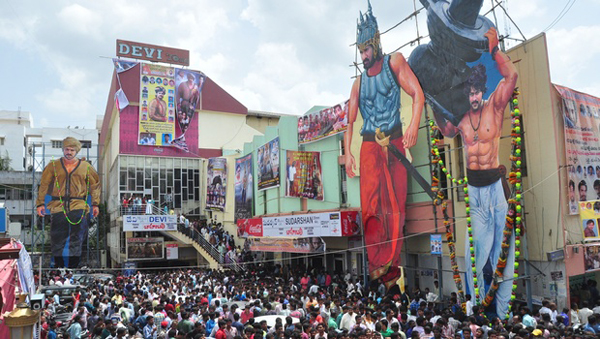Archive for the 'Film comments' Category
Poets’ summer: PATERSON, A QUIET PASSION
A Quiet Passion (Terence Davies, 2016).
So I write—Poets—All—
Their Summer—lasts a Solid Year—
They can afford a Sun
The East—would deem extravagant—
Emily Dickinson, “I Reckon–when I count it all,” no. 569
DB here:
From the Vancouver International Film Festival, I write on two new films you should see as soon as you can.
How to make a film respecting the power of poetry? More basically: What is that power? Does it lie in the fact that poetry can be a part of ordinary life? This seems to me the angle taken in Jim Jarmusch’s Paterson. Or does poetry’s power arise as an alternative to mundane intercourse, a realm in which we test thoughts and feelings beyond the flow of daily life? I think this is the angle taken in Terence Davies’ A Quiet Passion.
The secret notebook
Paterson drives a bus in Paterson. The bus’s destination display bears not a street name but rather the word “Paterson.” Such playful quirks, long a part of the American indie game, is as inoffensive as the film’s title (Paterson, of course). The milieu looks prosaic enough, with quasi-documentary shots of streets and the Great Falls. But Paterson owns a bungalow on a bus-driver’s salary, catches a 1930s horror film at a local theatre, and drops in at a saloon where a barkeep named Doc plays chess with himself. The town has more than its share of twins too.
In this slightly off-track version of a city, the protagonist’s Iranian-American wife Laura paints fabrics, bakes designer cupcakes, and wants to be a country singer. Meanwhile, Paterson has creative impulses of his own. He writes poetry.
Paterson is a quiet, genial fellow to whom you’d happily entrust your morning commute. His poems (written by New York School poet Ron Padgett) are conversational; the first one we hear begins: “We have plenty of matches in our house.” The poems are given their force by their homely details and the repetition of simple declarative phrases.
Repetition is built into the film’s block construction: A Week in the Life. Waking up, having breakfast, walking to the bus terminal, jotting down some verse before beginning his routes, lunch and more jotting, walking home, eating dinner, and visiting the bar—Paterson ‘s routines create a rhythmic matrix that we quickly learn. That the film’s structure is built around work routines makes sense. In America, a poet might be your bus driver, your doctor (William Carlos Williams), your insurance executive (Wallace Stevens), the farmer down the road (Robert Frost), or your teacher in business school (Marianne Moore).
As for poetic texture, the routines get treated in small-scale variations. Take the opening bed shot, an overhead view of the couple that announces a new day. One morning Laura isn’t there. Sometimes we don’t get a shot of Paterson checking his wristwatch. The weekend mornings lack the daily written title that the workdays get. A poetic principle of verse and refrain gets built into the film’s structure.
Finer-grain texture comes in the recitation of the verses as Paterson writes them into his scruffy notebook. We see the lines form on the surface of the screen, in freehand script, while montages of driving surge underneath them–as if these were coming to life in the course of the day. The fate of the secret notebook is probably the biggest dramatic twist in the film, but even that becomes part of a larger pattern after a melancholy Sunday walk.
And drama? There are moments of tension. Paterson is unenthusiastic about Laura’s buying a guitar, and an habitué of the bar seems to create a life-or-death crisis. Yet these and other problems slide away quickly. When Saturday night comes around, a kind of climax occurs. It tails off, subsumed in the playing out of motifs that were installed early on—rhymes, we might say.
As you’d expect in a film living under the aegis of Williams (author, of course, of Paterson the book of verse), it’s all about the discrimination of detail. “No ideas but in things” is the motto. The emblem becomes the Ohio Blue Tip Matches described in Padgett’s poem and shown to us in close-up. Laura reveals her poetic acumen when she asks if Paterson’s verse mentions the megaphone skew of the label’s lettering.
Paterson may write alongside a waterfall like a classic poet inspired by nature’s sublimity. But in tuning his ear to his passengers’ conversations and by finding epiphanies in mass-manufactured objects, he’s in the American grain.
Night thoughts
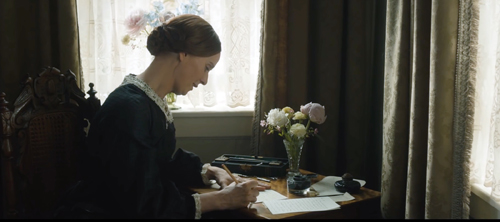
Paterson is so unassuming in his creativity that his film might have been called A Quiet Passion. That, though, is the title of Terence Davies’ tribute to Emily Dickinson. But not much about her is presented as quiet. The film starts with the tart young Emily declining to accept a place in Mt. Holyoke’s pious “ark of safety.” She prefers the soaring rapture of Bellini’s “Come per me sereno,” a bride’s thank-you to guests at her wedding. While her family listens politely in their concert-theatre box, she sways in sympathy with the singer. The scene seals her pledge to art.
Any biopic of the Belle of Amherst faces the problem of characterizing her through talk and action. One option is to make her meek and introspective. Another is to make her conversation as diffuse, oblique, and staccato as her verse. Davies has boldly tried another tack. He has made her one of a trio of eloquent women who swap epigrams as swiftly as if they were in an opera or an Oscar Wilde play. Davies seems to be suggesting that worldly (and wordy) banter with her kindly sister Lavinia and racier friend Miss Buffam gave Emily a sense of the blunt force of language.
Paterson is laconic and ruminative, like his verses, but Emily is a parlor dialectician. She hammers fierce comebacks at her father, at her brother (especially when he takes a mistress), and even at the devoted Vinnie. What authority she gains in her closed society emerges mostly from her wit and tongue. (Though she can calmly smash a plate too.) At the same time, Emily knows her words can wound. She’s miserable after snapping at the family servants, and after a volatile exchange with Vinnie she despairs of ever being a good person.
Here is a woman who feels the power and pain of language. Once we understand that, we’re better prepared to understand the inward turn of her verse. Unlike her dueling conversations, her poems are skewed and slanted, with unexpected jumps at every line, or dash. They twist nursery-rhyme cadences and simple vocabulary into Donne-like knots of phrasing. The film’s voice-over recitations make the verse even more elusive than on the page, but I don’t know how else Davies could have handled them. Even showing the lines as they emerge, as Paterson does with superimposed writing, wouldn’t fully satisfy. We need time to ponder the impacted syntax on display. I suspect that instead of trying to translate the perplexing force of Dickinson’s verse, Davies’ film exists as a parallel text, a supplement urging viewers to return to the poems after witnessing Emily’s socializing and suffering.
Familiar Davies themes emerge. Fiery spirituality clashes with hypocritical churchifying; family ties are fulfilling but also suffocating; a single room can enclose peace or stabbing pain. There’s the power of women’s friendships, alliances against a world bent on cutting them down. Davies reminds us that “women’s art” often involves handicraft. Emily is not only writer but book-maker, trimming and stitching little pages together into secular devotionals. These mini-books recall and mock those pious guides for meditation that could be tucked into purses and waistcoats.
Paterson writes in the daytime, while waiting to pull the bus out of the garage or on his lunch hour or even while driving. Emily, once her father gives his permission, writes from 3 AM into the morning. Accordingly, the bus driver’s poems, like those of Williams, have the evenly-lit clarity, if not the compression, of a haiku, while Emily’s verses, haltingly phrased, move in a hallucinatory blur. Jarmusch’s no-fuss staging and editing suit the unassertive texture of the verse and the driver’s days, while Davies, himself something of a chamber artist and a master of the musicalized image, scans his parlor tableaux with lush gravity.
Two films, each one both light and grave, adroit and solemn, though in different registers. Whatever cinematic poetry is, they aspire to it.
Michael Koresky has a superb discussion of Paterson at Reverse Shot, the Museum of the Moving Image site.
Note for the theoretically inclined: Paterson‘s structured routines and substitution-slots interestingly conform to Roman Jakobson’s dictum that the poetic function consists of the projection of the paradigmatic axis of language (alternative lexical items) onto the syntagmatic axis (the linear flow) of a text. See his “Closing Statement: Linguistics and Poetics.”
Another entry on this site considers Davies’ Sunset Song and his other films. As Moonrise Kingdom is one of our blog’s favorite recent films, it’s a pleasure to glimpse Jared Gilman and Kara Hayward as kids bringing anarchy to Paterson, N. J.
Paterson (Jim Jarmusch, 2016).
TONI ERDMANN, GRADUATION: Mediums, well-done
Graduation (Cristian Mungiu, 2016).
DB here:
More from this year’s Vancouver Film Fest, abundant as ever (over 200 features, over 300 films in all).
Comedy, Chaplin supposedly said, is life in long-shot, while tragedy is life in close-up. This is questionable on its face, but put that aside. What about medium shots? Maybe they’re either comic or tragic? Or maybe just neutral? Any shot framing the body from, say, the waist up to the head is the workhorse of most film traditions, and it’s ready to be recruited for almost any purpose.
I was led to think about this handy tool when watching two strong and enjoyable films, Cristian Mungiu’s Graduation and Maren Ade’s Tony Erdmann. Both directors made some similar artistic choices, such as that slightly swaying handheld framing that seems de rigueur in many films nowadays–the “free camera,” as the Danes call it. But the two films show different ways of exploiting the medium-shot of people talking. The differences, I think, depend on both genre factors and one crucially diverging choice.
Screwball comedy with a German accent
Toni Erdmann updates screwball comedy: a mischievous madcap disrupts the staid life of an uptight character s/he loves. In classic Hollywood the madcap might be a wild woman (Bringing Up Baby) or a free-spirited man (Holiday), with romantic union the result. The variation here is that the madcap is a father. Winfried tries through pranks and impersonation to loosen up his rigid daughter Ines, who’s striving to be a cool corporate barracuda.
The plot is a series of encounters in Ines’ high-stress professional life. Her rounds of meetings and cocktail parties are constantly invaded by the bulky Winfried. Sometimes he’s his unkempt self (often adorned with splayed monster teeth), sometimes he’s a fake businessman/diplomat named Toni Erdmann. When father shows up, she’s mortified. She resorts to the classic strategies of the screwball target: flight, pretending not to know him, and desperately going along with the masquerade in hope that it will pass. Finally Winfried breaks down her defenses, and we get the obligatory scenes when the by-the-book character finally lets loose (here, through a heartfelt song and later by a creative effort at party hostessing).
The premise of screwball is a bit of a Jonsonian power trip. We’re asked to sympathize with people who have enough leisure and money to punk everyone around them. The cruelty of the put-on, with trusting characters gulled by free spirits, is built into the genre. In Toni Erdmann we have to be ready to accept not only the deflation of a CEO, which is always fun, but also the terrorization of working stiffs like delivery men and mechanics. To the film’s credit, there is a moment when Winfried learns the price that others must pay for a retiree’s cute mischief. Along the way is some sharp satire on corporate predation and its fashions in “coaching” and “team-building.”
All this is played out in good old medium shots. And those in turn are embedded in good old shot/ reverse-shot.
Toni Erdmann relies on shot/reverse-shot technique primarily, I think, because of the need to show reaction shots. A good part of comedy is reaction, and camera ubiquity allows us to watch the gag and the payoff in a tick-tock editing rhythm. Ade can time people’s responses to Winfried’s sinister leer in ways that maximize the laugh.
Shot/ reverse-shot has of course long been a mainstay of classical Hollywood continuity style, partly because it mimics the flow of turn-taking in conversation. Like side-participants in a real-life situation, we shift our attention from speaker to speaker, thanks to the cuts.
Over-the-shoulder framings help anchor us in the space of the scene, so we always know where we are.
Assisting that sense of stability is the so-called 180-degree system of staging, shooting, and cutting. This keeps all the eyelines, postures, and backgrounds fairly consistent. At several points, though, Ade’s reverse angles “break the line,” shifting us across the axis of action. This creates what’s been called “200-degree-plus” staging and shooting.
Fortunately, our pragmatic sense of who’s talking to (or looking at) whom overrides the slight jump. The shift can be smoothed if there’s a strong cue–as here, when Winfried turns his head from the courier on his doorstep.
When you have several characters present, and you’re willing to break the 180-degree line in your reverse shots, you can cheat positions from shot to shot in remarkable ways. A cut can magically delete a character for the sake of emphasizing another one’s reaction.
For example, at a fancy party, Winfried-as-Toni approaches a woman and claims he works at the German embassy. The first shot favors the woman, her friend, and a nervous Ines, who tries to pull Toni away.
But when we cut to a reverse of Toni, Ines is no longer beside the blonde woman.
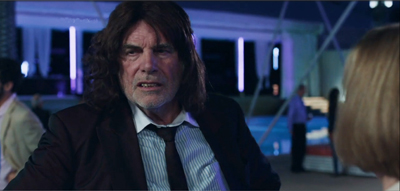
She has been shifted to the left–in fact, moved completely offscreen–in order to supply a clear view of Toni. His sharp glance to the left confirms her position.
Cheating shot/ reverse-shot positions is a common tactic of classic continuity filmmaking, and Ade uses it freely. The more characters who crowd in, the more chance to cheat them. In some shots during the big party, Ines is close beside her boyfriend as her boss greets Toni. But in the 180-degree reverse angles the couple gets spread out, with the man pushed offscreen entirely, before a new setup brings them back–and deletes the boss.
It’s remarkable how little we notice these shot-to-shot disparities as long as positions are grossly consistent, and as long as we’re given other things to pay attention to. (Dan Levin has studied filmic “change blindness” experimentally.)
Throughout, Ade’s cutting and camera placement help us enjoy, moment by moment, the shocked, bewildered, and bemused responses to Winfried/Toni’s campaign to humanize Ines.
The case of the missing reverse shot
Change the genre from comedy to drama, though, and minimize editing, and you get something else. You get, for instance, Graduation (Bacalaureat).
Mungiu traces a few tense days in the life of Romeo, a provincial doctor living in a bleak housing flat. His daughter is promised a scholarship if she does brilliant exams, but before she can take the first test she’s assaulted and the trauma threatens to wreck her performance. To protect her, Romeo uses his network of friends to arrange for favorable grades. The scheme precipitates crises with the daughter, her boyfriend, Romeo’s wife, his mistress, and a mysterious attacker.
The film is essentially a set of two-handed dialogues, tracing how the pressure on Romeo builds from day to day and hour to hour. These encounters are filmed mostly in medium shots, as in Toni Erdmann, but with one essential difference. The shots are long takes, and they’re kept fairly stationary—that is, no circling or panning of the camera. Handling some scenes in just a single shot, Mungiu often avoids the shot/reverse-shot cutting we see in Ade’s film.
This choice might seem akin to the virtuoso long takes of Iñárritu in Birdman. But as I tried to show back when, Iñárritu’s long takes actually mimic the patterns and effects of shot/reverse-shot editing. In Birdman, we’re denied nothing because the moving camera always picks up the reaction that would normally be captured in a reverse-angle cut. By contrast, Mungiu doesn’t give us the long-take equivalent of continuity editing; he denies us reaction shots quite stringently.
In The Graduation, characters tend to interact in in lengthy profiled two-shots, not 3/4 reverse angles.
This framing gives us some access to the characters’ emotions. It’s worth mentioning, though, that profile shots aren’t strongly informative about a person’s facial expression. A frown or a smile is more “readable” in the 3/4 framing favored by reverse-angle cuts.
More remarkable, though, are those passages in which Mungiu simply denies us access to Romeo’s facial expressions by pivoting him away from us and denying a reverse shot.
Actors have turned their backs to the audience for a long time in both theatre and film, usually to enhance a gesture, to call attention to another actor, or to delay the revelation of the face. But since the reverse-angle cut is such an ingrained convention, we count on camera ubiquity; we expect to see everything. When characters have their backs to the camera, and the director doesn’t cut to an angle that reveals their reactions, this choice can have powerful narrative effects. It can make the character’s psychology more opaque and mysterious. It can also build suspense as we wait for some clues (in words or gestures) to the character’s response.
The withheld reverse angle, within longish takes, was a prominent tactic in Antonioni’s 1960s style, as in L’Avventura.
Mungiu isn’t quite so flagrant, favoring 3/4 rear view like the over-the-shoulder view of orthodox shot/reverse shots. This will do duty for orthodox POV cutting: We see what Romeo sees but not exactly through his eyes.
The result is to attach us to the protagonist but not in a deeply subjective way, as Hitchcock might with intense optical POV shots. These shots might suggest a perceptual subjectivity–we see what Romeo sees, more or less–we don’t know how he’s reacting. Sometimes, as when he and a colleague inspect an X-ray, we get almost no sense of the reaction, or what they’re reacting to.
In addition, Romeo is a fairly phlegmatic man anyhow; he’s hard to read even facing front.
His failed ambitions and troubled relation to his wife, as well as the mess he’s making of the exam scheme, seem to have given him a fixed, furrowed anxiety. I doubt that even Toni Erdmann could make him smile.
Still, most directors would probably have filmed Romeo driving his daughter to school, from an angle in front of the car, shooting through the windshield. And most directors would have revealed something of his response when, as his scheme unravels, the school principal orders him not to contact him again or come near his house.
Even more striking, at a climactic moment, he’s questioned by two policemen. I don’t have an illustration for you, but we’re perched over his shoulder and watch the two cops–not unsympathetic–explain to him at length the punishment likely headed toward him. We get no chance to see whether his facade cracks even a little. But observing him so often as a solid lump in the foreground or on the edge of the shot gives him, I think, a sort of obdurate resistance that suggests he will resist what’s coming. In these grim circumstances, stubborn stolidity gains a heroic quality.
Other characters, notably his wife and daughter, get framed in ways that allow us to track their emotions. It seems somewhat ironic that the sunniest, most straightforward and untroubled faces we see are those of the class lined up for the graduation picture.
No surprises here. The head-and-shoulders shot gets a lot of its impact from its coordination with other stylistic choices: the decision to cut (or not to cut), the selection of the angle (frontal, or from behind), and the overall tone of the film (grim or light-hearted). There are no general rules. Contra Chaplin, the close-up can be comic, as in Harold Lloyd. The long-shot can be tragic, as in Hou Hsiao-hsien or Edward Yang or Theo Angelopoulos. As with these shot scales, the workhorse medium shot is coordinated with other techniques to achieve its results in different contexts.
Thanks to Michael Barker of Sony Pictures Classics and Greg Compton of Sony Pictures Entertainment for their generous help in preparing this entry. Toni Erdmann is scheduled for U. S. release by Sony for 25 December. Graduation is distributed by IFC in the Sundance Selects collection; no U. S. release date yet announced.
I discuss the blend of cinematic convention and social intelligence elicited by shot/reverse-shot techniques in the essay “Convention, Construction, and Cinematic Vision,” in Poetics of Cinema, 57-82. On the quick information pickup involved in certain facial views, see Vicki Bruce, Tim Valentine, and Alan Baddeley, “The Basis of the 3/4 View Advantage in Face Recognition,” Applied Cognitive Psychology 1 (1987): 109–10; and Robert H. Logie, Alan D. Baddeley, and Muriel M. Woodhead, “Face Recognition, Pose, and Ecological Validity,” Applied Cognitive Psychology 1 (1987): 53–69.
On the 200-degree-plus style in modern film and television, see The Way Hollywood Tells It, 177-179. On change blindness, an earlier blog entry is here. Another entry bearing on the matter, also VIFF-inspired, is “Where did the two-shot go? Here.”
The laconic rear-view shot became a common tactic of modernist cinema. For other examples, you can see this entry on Béla Tarr. But Mizoguchi got there quite a bit earlier.
Toni Erdmann (Maren Ade, 2016).
A decade at the Vancouver International Film Festival
The Red Turtle (2016).
Kristin here:
Recently this blog passed its tenth anniversary. Our first modest entry, on Christine Vachon’s book A Killer Life, was posted on September 26, 2006. The second was “A film festival for all seasons,” the first of David’s five reports on that year’s Vancouver International Film Festival, where he was a judge in the Dragons and Tigers competition for young Asian directors. Since then we both have come to VIFF nearly every year. Its organizers and staff are always welcoming and we can see lots of films in a relatively relaxed atmosphere free from the red carpets, the markets, and the celebrities that make some of the bigger festivals difficult to navigate. We’re delighted to be back in Vancouver now, reporting on its rich array of offerings for a tenth time.
The Rehearsal
Canadian-born, New Zealand-bred, New York-dwelling director Alison Maclean gives us The Rehearsal (2016), her first feature since her best-known film, Jesus’ Son (1998). In between she has been primarily working in television, including episodes of Sex and the City and The Tudors.
The film begins with an image of an Asian woman in a blonde wig and ultra-high-heel shoes facing directly into the camera and miming a tennis game (see bottom). Such an arresting opening is a wise move, since the film’s early portions are mostly expository. The opening introduces Stanley, a young Maori man who gains acceptance to a high-pressure, prestigious drama school, despite his apparent lack of the necessary talent and drive. Overcoming his initial listlessness, Stanley gradually bonds with his classmates. He also blossoms somewhat under the tough-love approach, sometimes verging on cruelty, that is the policy of Hannah, the demanding head of the school (Kerry Fox, above, best known for playing Janet Frame in An Angel at My Table).
The opening image turns out to be a flashforward to a rehearsal of an original playlet that Stanley and a group of teammates must put on at the end of the school year. For their story they seize upon a current local scandal in which a tennis coach has had an affair with an underage pupil. Stanley has begun dating the girl’s sister Isolde, which gives him knowledge about the situation that the group incorporate into their play. The main suspense arises from Stanley’s failure to tell Isolde what his team is up to, despite the fact that inevitably she will find out. More drama arises from the effects of Hannah’s harsh methods on the students, particularly Stanley’s vulnerable roommate.
The Rehearsal currently has no American distributor but will play on October 5 at the New York Film Festival.
The Confessions (Le Confessioni)
Early in The Confessions a spectacular drone shot follows a moving car from above the treetops. Eventually the car arrives at a driveway crowded with news photographers, and the camera leaves it to reveal a huge modern hotel and then move beyond it over ta body of water. Though not as flashy, the rest of the film has the sort of lush cinematography (above) and rich musical score that are familiar from such other recent prestigious Italian productions as The Great Beauty.
The plot involves a sort of bitter parody of a G8 meeting, with eight representatives of major countries meeting under the guidance of the head of the International Monetary Fund. They are preparing to execute some sinister plan, under the guise of “creative destruction,” that will solve a current international financial crisis in a way that will benefit rich countries at the expense of the poorest ones. Daniel Roché, the head of the IMF, has also invited an Italian monk, Roberto Salus (played by Tony Servillo, so memorable in The Great Beauty and especially Il Divo), to attend.
The reason for Salus’ presence is not clear, though Roché requests him to hear his first confession in twenty years. Roché is soon found dead. It’s apparently a suicide, but some of the finance ministers attending the meeting seemingly try to eliminate Salus by casting him under suspicion of murder. The film turns into a cat-and-mouse game, with each seeking out Salus for devious conversations, punctuated with tantalizing flashbacks that gradually reveal what Roché had revealed during the confession scene.
Although on the surface the film seems to be developing into a thriller, it is too playful to be taken entirely seriously, and the wise, reserved Salus always delivers the final sardonic comic topper in his exchanges with each of the villains. There is even a suggestion of a sort of magical realism at a few points. Ultimately The Confessions is a somewhat uneasy mixture of genres but a highly entertaining one.
The Red Turtle
In the early days of the blog (December 10, 2006), I wrote an entry claiming that in contemporary cinema, animated films are on average more likely to be stylistically superior to live-action ones. Animated films have to be intensively pre-planned, including recording soundtracks in advance. Such careful preparation, which eliminates the easy reliance on “coverage” and limits changes in post-production, imparts a rigor and care that are too often missing in live-action features. Two experiences with animated films here at Vancouver reinforce my point.
David and I agree that The Red Turtle is a standout among the films we’ve seen so far. It’s an animated feature by Michael Dudok de Wit, the Dutch animator who won the animated-short-film Oscar in 2000 for Father and Daughter. The Red Turtle won a Special Jury Prize at Cannes this year. It also has Studio Ghibli’s name attached, which might lead to some raised eyebrows.
Studio Ghibli’s three legendary animators all retired in recent years: Hayao Miyazaki, after The Wind Rises (2013); Isao Takahata, after The Tale of the Princess Kaguya (2013); and Hiromasa Yonebayashi, after When Marnie Was There (2014). Rumors that the studio would shut down fortunately proved false, despite the fact that its crew of animators was disbanded. The Red Turtle is the first film to bear the Studio Ghibli name since Marnie. The studio, not Dudok de Wit, initiated the project, and perhaps it will henceforth support occasional hand-picked productions like this one.
Though The Red Turtle uses traditional cell animation, it does not particularly imitate the studio’s familiar style Nevertheless, the film is far from being a radical departure from its previous output. For one thing, The Red Turtle is vitally concerned with the depiction of nature. It opens with a storm that drives a single survivor from a shipwreck onto the beach of a small island, uninhabited by humans. His first contact with living things there comes when a curious sand-crab crawls up his pant-leg, and a group of these crabs provides touches of comic relief throughout.
Three times the unnamed man tries to escape aboard bamboo rafts (above), but each time a large red sea turtle destroys his craft (see top) and forces him back to the island. In the story’s first fantastical event, the turtle transforms into a woman, and the two soon fall in love, Adam and Eve in a sparse Garden of Eden. They gain a son, a tsunami introduces a note of threat into the idyllic depiction of nature, and ultimately they face mortality. The simplicity and fantastical elements of the story would be perfectly convincing as a rendition of an existing myth, but the story is completely Dudok de Wit’s invention.
The three human figures are drawn very simply and look like they were rotoscoped, though I can find no confirmation of that online. The depiction of the natural landscape and the creatures that inhabit it are, however, stunningly beautiful. Without attempting a photorealistic look, Dudok de Wit’s team have captured the look and movement of sunlit seawater, the rhythmic rustling of leaves, and even the differences in color between the exposed and the submerged surfaces of woolsack blocks of granite at the ocean’s edge. It is almost as if they have managed to rotoscope all of nature.
The classic films by the main directors at Studio Ghibli are more elaborate and complex than The Red Turtle, but the new film suggests that the studio will maintain its high standards in its future productions.
The Red Turtle was bought by Sony Pictures Classics and is scheduled for a mid-December American release.
Window Horses (The Poetic Persian Epiphany of Rosie Ming)
While The Red Turtle is a high-profile animated film, Window Horses originated as an Indiegogo project. Its success in that campaign led Sandra Oh to back the film, signing signed on as a producer and providing the voice of the film’s heroine. The project gained additional support, including by the National Film Board of Canada. Still, it is likely to remain largely a festival item (it premiered at the Annecy International Animation Film Festival), with only a limited theatrical release in Canada early next year. (Information on that release is not yet available online, but news will presumably be posted on the film’s website.) It exhibits a lively imagination and stylistic sophistication that deserve a wider audience, which with luck it will achieve via streaming.
The story centers on Rosie Ming. With her Chinese mother dead and her father having apparently abandoned his family to return to Iran, she lives in Vancouver with her maternal grandparents. A self-published book of her verses leads to an invitation to a poetry festival in Shiraz. Donning a full chador in the hopes of fitting in, she finds herself surrounded by women wearing simple scarves and vibrant clothing.
The animation itself is colorful, with stylized faces that are vaguely reminiscent of Picasso (as in the tour-bus scene, above). Rosie stands out in her utter simplicity, rendered as a black-clothed stick figure with a round, white face sketched in only by eyes and, when she speaks, a mouth. Recitations of poems are accompanied by scenes of animation is a variety of styles, contributed by such animators as Kevin Langdale, Janet Perlman, Bahram Javaheri, and Jody Kramer.
Overall, it is an engaging and entertaining film, showing how much an independent filmmaker can do with limited means. In that it reminds me of Nina Paley’s Sita Sings the Blues.
Films that have particularly impressed us so far include Pablo Larrain’s Neruda (playing again on October 9), Cristian Mungui’s Graduation (playing again October 5 and 11), and above all Terence Davies’ A Quiet Passion (playing again on October 9). We’ll be blogging about these and others over the next several days.
The Rehearsal (2016).
It’s all over, until the next time
Our Little Sister (Kore-eda Hirokazu, 2015).
DB here:
The perennial Silly Season topic, The Death of Film, is back.
In June, Huffington Post‘s Matthew Jacobs announced “The death of Movies As We Know Them.” He laments the loss of “solid storytelling and bankable stars.” In August, Brian Raftery asked: “Could this be the year that movies stopped mattering?” The author argues that now movies are “Something to Do When the Wi-Fi’s Down.” Echoing the virality theme, Ty Burr announced that two albums, Beyoncé’s “Lemonade” and Frank Ocean’s “Blonde,” “came packaged with better movies than anything in theatres.” For Burr, the summer season confirmed that audiences are more interested in grazing among YouTube clips and luxuriating in eight-hour video serials than watching a feature film. “The two-hour movie, especially in its larger and more commercial form, is becoming a relic.”
Richard Brody eloquently replied to Raftery, noting Beyoncé’s debt to Julie Dash and Khalik Allah’s films. Brody has been around this block before, as I noted in a 2012 blog entry.
The cinema-is-dead complaint, Richard Brody helpfully points out, is now an established genre of movie journalism. In the last few weeks David Denby, David Thomson, Andrew O’Hehir, and Jason Bailey have in different registers sought to revive this quintessentially empty polemic. I’ve gone on about the tired conventions of film reviewing about once every year on this soapbox. (Try here and here and here and here; Kristin got in some licks too). For now I’ll just say that I’m convinced that the Death of Cinema (or Hollywood, or the Intelligent Foreign Film, or Popular Movie Culture, or Elite Film Culture) is simply a journalistic trope, like Sequels Betray a Lack of Imagination or This Movie Reflects Our Anxieties. In short: an easy way to fill column inches.
But after four years, maybe things really have deteriorated. So let’s get specific. What’s really going down the tubes? The theatrical side of the industry? Quality? Cultural cachet?
Movies, your best entertainment value
Bar area of Orange Cinema Club, Beijing.
Let’s look at some current evidence about the industry, thanks to the redoubtable Cinema research division of IHS Media Technology.
The newest symptom of cinema’s demise, according to many, is the rise of Netflix and other streaming platforms. Serial TV is attracting a lot of attention, true, but streaming has long relied on licensing feature films from studios, independents, and overseas companies. TCM and Criterion are launching FilmStruck as a new channel chock-full of classic films from Hollywood and elsewhere. Amazon and Netflix have also begun acquiring and financing features to guarantee a supply of those two-hour films that for some reason people still want to watch.
But what about movies in theatres? Actually, things are pretty robust. Despite everybody viewing at home and on the go, for many years theatre growth has been phenomenal. In 2015 the world added about 12,000 screens, hitting a new high: 153,163. Not counting all our “second screens” (and third), there are more movie screens now than ever before.
By the way, those of us, me included, who worried that the rise of digital exhibition would cause a drop in screens were wrong. Digital was a shot in the arm to theatrical exhibition, and it made 3D a viable platform. That format shows signs of growth, chiefly because of China, and now 16-20% of box-office grosses come from 3D screenings.
In keeping with the expansion of exhibition, for the last decade, the global box office has risen steadily. Almost every year sets a record. The new height is $37.7 billion for 2015, and it seems likely that 2016 will beat that.
As for number of admissions, 2015 also set a record: 7.4 billion, a jump of 13% over 2014. This is a bit more than one ticket for every man, woman, and child on earth. The first half of 2016 is ahead of the same period last year.
Of course revenues don’t equal profits. Jacobs is especially concerned that some big films have been losing money in their domestic theatrical run. But most films lose money in that run. For a long time, ancillary markets (DVD, overseas cable, merchandising, etc.) made up for the deficits. More and more, overseas theatrical is helping in a big way. In a recent rundown, of the summer’s top twenty hits, a print story in The Hollywood Reporter indicates that foreign grosses outweigh US/Canadian ones in most cases, and sometimes by a lot.
For example, big as Captain America: Civil War was in the US, 65% of its $1.1 billion haul was due to the offshore market. X-Men: Apocalypse got half a billion theatrical, 71% of which came from the international audience. Ancillaries will still need to kick in, given the mammoth budgets of films like these, but those ancillaries piggyback on theatrical visibility. As ever, the big pictures pay for a lot of lesser films.
Moreover, so many costs are buried or dispersed in overhead, debt service, tax incentives, deferred payments, far-fetched studio expenses, and the like that it seems hard to know what final profits really are. Nor will we know what, if any, profits are yielded by films from countries with subsidized film industries.
There are many things to worry about in the exhibition business, but it doesn’t seem on the verge of collapse. Let’s keep a sense of proportion. Here is what the death of “our cinema” might really look like.
Theatre admissions fall 45% over six years. Studio profits fall 80% over the same period. One-sixth of theatres close. Major overseas markets refuse to remit the earnings of Hollywood films. Audiences turn increasingly to other leisure activities.
This was the state of the American film industry in 1953. The prosperous war years, culminating in the all-time admissions high of 1946, were over and the studios went into sharp decline. Thanks to the 1948 Supreme Court “Divorcement Decree,” the studios lost control of their theatres, relinquishing not only valuable showcases for their product but also millions of dollars of prime real estate.
Yet as we know, 1953 didn’t end cinema, not even American cinema. As the old studio system waned, a new one eventually replaced it. In the process, Hollywood continued to make major films. Filmmaking abroad—in Asia, Europe, and South America especially—flourished. Film festivals sprang up, and a new young public proved eager to watch movies from a variety of cultures. Avant-garde and documentary movements gained traction, partly because of the widespread dissemination of 16mm.
No one, so far as I can tell, predicted the end of cinema, or Hollywood, because of the 1947-1953 crisis. That person would have looked very foolish. Things today aren’t nearly so severe.
Long, hot summers
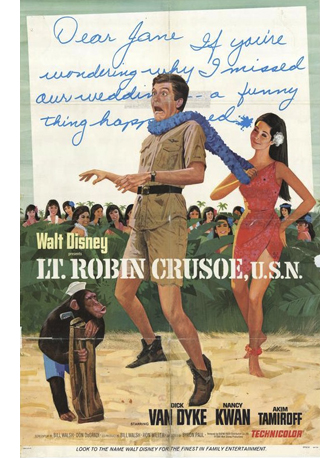 What about quality? A. O. Scott points out that the way to quell fears for the End of Good Cinema is to go to a film festival. It’s good advice that we’ve given as well. Richard Brody, who has I think seen everything, responds to Raftery by reminding us of many valuable films that the naysayers ignore. Another way to remain calm is to look at a little history.
What about quality? A. O. Scott points out that the way to quell fears for the End of Good Cinema is to go to a film festival. It’s good advice that we’ve given as well. Richard Brody, who has I think seen everything, responds to Raftery by reminding us of many valuable films that the naysayers ignore. Another way to remain calm is to look at a little history.
Things often seem grim at summer’s end. Let’s go back fifty years, to the summer of 1966. In those days, the blockbusters and prestige pictures were saved for fall and winter. Indeed, the blockbusters were largely the prestige pictures, the adaptations of novels and plays. The big grosser of the year was Hawaii, released in October. Two others were The Bible: In the Beginning (September) and A Man for All Seasons (December). But two of the top-grossers hit the jackpot in the summer: Who’s Afraid of Virginia Woolf? (July) and Lt. Robin Crusoe, USN (June).
Pause on this last title. Lt. Robin Crusoe, USN was an indisputably lowbrow hit, a Disney comedy starring Dick Van Dyke. The fact that it earned $10.1 million (about $75 million today) might well have set critics worrying about American tastes. Worse, they might have concluded there was no hope, because from 1950 to 1970, twenty Disney films appeared in the annual top five. That record includes not only animated classics but In Search of the Castaways, That Darn Cat, and Darby O’Gill and the Little People–enough to make intellectuals despair of American moviegoers. Robin Crusoe‘s summer success might have seemed another sign of End Times.
Summer 1966 also saw The Ghost and Mr. Chicken, Fantastic Voyage, the remake of Stagecoach, a Bob Hope comedy, the low camp of Batman, and the high camp of Modesty Blaise. The 1966 counterpart to our spate of superhero sagas was a cycle of spy movies, somber or spoofy. The summer yielded Blindfold, Arabesque, and even The Man Called Flintstone. Along with these came Nevada Smith, Khartoum, What Did You Do in the War, Daddy?, This Property Is Condemned, and Wild Angels.
Some of these are well-remembered, mostly by viewers exposed at an impressionable age. For prestige there was and remains Virginia Woolf. For auteurists, there was Three on a Couch and Torn Curtain, and perhaps Modesty Blaise. As for the rest, most were and are still decried as junk.
Things were not looking good for American cinema. The Sound of Music had just won the Best Picture Oscar, a middlebrow shot across critics’ bow, and Pauline Kael was turning angry firepower on the massive threat posed by The Singing Nun. In the summer, the Times lambasted Hitchcock and Jerry Lewis. As far as I can tell, the follow-ups to the Bond boom pleased hardly anybody.
In sum, we forget just how godawful summer movies can be, year in and year out. The few we remember after Labor Day bob up from a river of sludge. We should be grateful for Indignation, Finding Dory, Lights Out, The Shallows, Hell or High Water, Don’t Breathe, The BFG, Kubo and the Two Strings, and probably half a dozen others I haven’t seen. (But not Jason Bourne, which I have.) Ben-Hur wasn’t as terrible as I’d been led to believe.
And of course, everybody’s pumped for the fall, for Snowden and The Arrival and The Birth of a Nation and La La Land and Manchester by the Sea and all the rest. 1966 critics were looking forward as well, but to what? Not only Hawaii, The Bible, and A Man for All Seasons but also Is Paris Burning?, Grand Prix, Any Wednesday, The Sand Pebbles and more spy movies (Gambit, The Quiller Memorandum). Not so exciting by our standards; Big Pictures were more square then.
True, also coming up in the fall of ’66 were The Fortune Cookie, Seconds, A Funny Thing Happened on the Way to the Forum, Fahrenheit 451, The Professionals, Loves of a Blonde, and Blow-Up. But even then some critics stayed unhappy. Kael denounced Blow-Up, and Vernon Young intoned: “The party’s over. . . . Another phase of film history, in many ways the most creative, is drawing to a close.” Sound familiar?
Conversation starters and stoppers
End-of-movie writers argue that pop music and Quality Television are usurping the cultural place of film. But I’m skeptical, because I don’t think film is playing in the same arena.
Odd as it sounds, film has never been popular on the scale of other mass media. Before TV, radio listeners far outnumbered film audiences. Via radio and records, a hit tune reached more people than nearly any movie. Even today, radio audiences are surprisingly big. Nielsen reported in 2014 that just in the 18-35 age group, 65 million people listen to radio broadcasts each week. That’s nearly three times the average number of all viewers who attend movie theatres in a week.
Once TV came along, it became another truly mass medium. 73 million people, over a third of the US population, watched the Beatles on Ed Sullivan in 1964. TV is still the big game. More than 20 million people watch The Big Bang Theory each week. It’s reported that 8.9 million people watched the season finale of Game of Thrones in original cablecast, and 23 million in all its iterations. Yet, again, about 23 million people see all the movies playing in a given week.
The plain fact is that visiting a theatre to see a movie has been, throughout most of American history, a middle-class pastime. It’s relatively expensive, and getting more so. It’s not quite niche, not as rarefied as theatre or concert music or novels, but still not on the scale of other media. We ought to expect that memes will spread faster and more pervasively in pop music and television platforms.
Our critics are concerned that films aren’t part of what Raftery calls “the pop-cultural conversation.” “What in popular culture got people excited or even interested over the last few months?” asks Burr, going on to worry that movies didn’t do so. This is a strange criterion for judging films. Hula hoops, Rubik cubes, Chia pets, and Donald Trump’s coiffure have all been part of the cultural conversation. Some good films excite lots of people, and some don’t (partly because those people don’t know of them). And of course many people got excited by films Burr and Raftery considered bad, like Suicide Squad. Excitement may not be a great standard for excellence.
The cultural-conversation gambit suggests that mere popularity needs to be accompanied by a special jolt, the hum of nowness, the throb of hipness. Financially successful films like The Jungle Book or Finding Dory don’t give off much buzz. Where does that special ingredient come from? Apparently, now, the Netizens. It’s natural that critics, who are assigned to surf the waves of mass tastes, would identify important art with what’s trending on Facebook. It’s their job to hop on what’s hot.
Or in truth, help make it hot. When critics treat what’s buzzy as valuable, they agree with marketers, and cooperate with them. How many critics who loved The Dark Knight had been prompted by the campaign that played up “Why So Serious?” and other memes that publicists thought would stick? Kristin has documented how The Lord of the Rings marketers set the agenda for journalists by means of junkets and Electronic Press Kits (above), while wooing fans with carefully judged opportunities to participate online (a “pop-cultural conversation,” for sure). The typical big film is positioned by the marketing campaign, and even unanticipated responses, especially if the film is strategically ambiguous, can feed ticket sales.
The People don’t start the cultural conversation; they react to what they’re given. The conversation is started by the studios, and they try to channel it. They generate the “controversies” about making the protagonists of Star Wars Episode VII: The Force Awakens a woman and an African American man. The critics pick up the story. (Remember: column inches.) Viewers dutifully enter their opinions on blogs, tweets, and comments columns–which the critics then re-spin. As Brody points out of Quality TV, it’s all about expanding discourse, indefinitely. Criticism begets “comments” which beget chitchat. This is less a conversation than a perpetually chattering flashmob.
A side note: I wonder if making cultural buzz a criterion of worthwhile cinema doesn’t owe something to the influence of Pauline Kael. She sent contradictory signals on this score, worrying that audiences were too easily bought off; the industry jollied them into accepting junk as fun. But she thought that one reason to like, say, Bonnie and Clyde was the fact that it was “contemporary in feeling.” It brought into movies “things that people have been feeling and saying and writing about.”
For a moment let’s accept the assumption that worthy movies have some broader cultural impact. How could we measure that? I suggest the Tagline Test. A movie enters the culture when a line becomes instantly recognizable. At its best, the tagline applies to an immediate situation. You step into a startling new setting and tell your friend you don’t think you’re in Kansas any more. You talk about your boss making you an offer you can’t refuse. You’re bargaining and you say, “Show me the money.” TV gives us plenty of catchphrases, of course. (“You rang?” “Not that there’s anything wrong with that.” “Don’t have a cow, man.” “That’s what she said.”) This is one symptom of a show’s buzziness.
When I came up with the Tagline Test, I thought it supported the doomsayers’ diagnosis. I couldn’t think of many memorable lines from films after the 1980s. Had TV taken over the traffic in catchphrases? Crowdsourcing among two fairly diverse populations came up with a big set. Here’s a sample:
Hasta la vista, baby. Houston, we have a problem. That’ll do, pig; that’ll do. I drink your milkshake. The Precious (enunciated in a high voice). With great power comes great responsibility. Stop trying to make fetch happen. She doesn’t even go here. Stay classy. That escalated quickly. The first Rule of Fight Club… 60% of the time, it works every time. Little golden-haired baby Jesus in the crib. Schwing! Coffee is for closers. King of the World! Stay alive; I will find you.
The Big Lebowski is a virtual encyclopedia of them: The Dude abides. Obviously you’re not a golfer. That rug really tied the room together. Nobody fucks with the Jesus. So too Napoleon Dynamite: Whatever I feel like I wanna do GOSH! I’m pretty much the best in the world at it.
Maybe you don’t agree that these are all equally common; I didn’t know about the Mean Girls and Napoleon Dynamite ones. But all I need to show is that recent movies have entered the “cultural conversation” quite literally. Maybe it just takes months or years for movie taglines to replicate in everyday life. Anyhow, those who want movies to get all buzzy don’t have to worry. With Oscar season upon us, the frenzy will begin. In fact it already has, with Nate Parker’s The Birth of a Nation.
Who’s we?
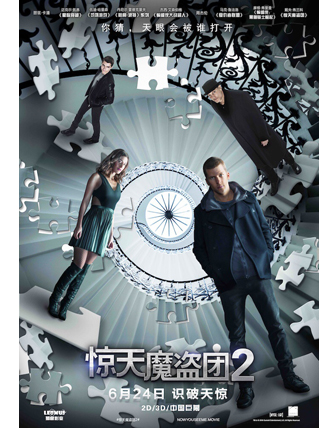 In talking about “our” cinema, I’ve been too glib, though this angle fits with an assumption of the death-knoll critics (“Movies as We Know Them”). Of course, Jacobs, Raftery, and Burr all acknowledge that Hollywood isn’t making movies just for us; it’s a world industry. People elsewhere (many recently arrived in the local equivalent of the middle class) seem keen to participate in American popular culture, with fashion, music, TV, and websites. Hollywood entertainment, lame as it often is, is part of being cosmopolitan.
In talking about “our” cinema, I’ve been too glib, though this angle fits with an assumption of the death-knoll critics (“Movies as We Know Them”). Of course, Jacobs, Raftery, and Burr all acknowledge that Hollywood isn’t making movies just for us; it’s a world industry. People elsewhere (many recently arrived in the local equivalent of the middle class) seem keen to participate in American popular culture, with fashion, music, TV, and websites. Hollywood entertainment, lame as it often is, is part of being cosmopolitan.
Still, maybe it’s time to admit that we don’t own Hollywood. Maybe we never did, but it seems clear that with globalization “our” popular cinema is becoming something else–not exactly “theirs,” but not wholly ours either. Now You See Me 2 may have attracted only mild interest here: little cultural chitchat, except maybe among magicians, and $65 million box office (less than Lt. Robin Crusoe, USN). But it garnered $266 million internationally. Nearly a hundred million of that came from China, perhaps partly owing to long stretches set in Macau and short stretches featuring Jay Chou Kit-lun. And the director was Asian-American Jon M. Chu.
Now Lionsgate announces a Now You See Me spinoff, a feature co-production with China that will use local stars. So who owns this franchise? “Us” or “them”? If it disappoints us and pleases them, how does that mean that movies are so over? Maybe other countries’ cultural conversations are pulsing with talk of the Four Horsemen (one of whom is a woman).
It’s long been obvious that other film industries create their own versions of Hollywood. Europe, India, and Hong Kong have done it for decades. Current Chinese hits borrow from “our” rom-coms, action pictures, and comedies. In Stephen Chow Sing-chi’s The Mermaid, you can watch a blockbuster premise coming unglued. It’s a mixture of sentiment, message, slapstick, and bad taste; Hollywood twisted up in Chow’s characteristic funhouse mirror.
This won’t stop. One of the most astonishing and puzzling facts of contemporary cinema gets almost no press, maybe because it contravenes the death-of-film narrative. Over the last ten years, there has been a huge rise in the number of feature films.
In 2001, the world produced about 3800 features annually. The number passed 4000 in 2002, passed 5000 in 2007, and passed 6000 in 2011. In 2014, IHS estimates, over 7300 feature films were made in the world. There are now fifteen countries that produce over 100 features a year. As a result, only 18% of the world’s features come from North America. The boom took place despite the rise of home video, cable, satellite, DVD, Blu-ray, VOD, and streaming. And it happened despite the fact that American blockbusters rule nearly every national market. This may be a bubble, or it may be genuine growth. In any case, we ought to investigate the reasons that a great many people around the world stubbornly persist in making two-hour films. They don’t appear to care if We sense a summer slump.
While I was preparing this entry, Kristin and I went to Our Little Sister, Kore-eda Hirokazu’s 2015 film about three sisters abandoned, first by the father, then by their mother, and raised by the moderately stern oldest sister. The plot follows what happens when the trio takes in their half-sister after her mother dies. This is a movie that’s bereft of villains and almost totally lacking in conflict. The sisters’ misjudgments and flaws cause them problems, and sometimes they quarrel, but mostly we see decent people trying to lead happy lives, and largely succeeding. Compared to Kore-eda’s debut, Maboroshi (1995), it’s pictorially rather conventional. (That damn sidling camera.) But its episodic, open-textured plot, its quiet depiction of changes across seasons and years, and its casually serene vision of family and community make it one of the most enjoyable and moving films I’ve seen this year.
Based on the graphic novel Umimachi Diary, the film participated in Japan’s “cultural conversation.” It’s certainly a mainstream commercial movie, of a sort that Japanese studios have turned out for decades. It won solid attention on the festival circuit too. It earned a 92% rating on Rotten Tomatoes, up there with Kubo and Hell or High Water. But such a reserved, sentimental film will never get the edgy buzz that our doomsayers want. Sentiment, after all, is anathema to our dominant mode of consuming pop culture, that of cool, ironic knowingness.
I don’t want to oversell Our Little Sister: Kore-eda is no Ozu. But this film and many others remind us that worthwhile films are still made, and released, and available outside the circus tent of Entertainment Weekly cover stories. (In this case, Americans’ thanks should go to Sony Pictures Classics, now celebrating its 25th anniversary.)
In short: Forget the zeitgeist; it likely doesn’t exist, apart from marketers’ dreams and journalists’ deadlines. Forget the cultural conversation; there’s not only one. Seek out the films that matter to you, and not “to us.” Stay classy!
Thanks to correspondents on two listserves, that of Communication Arts film folk and that of the Art House Convergence. A great many people made many suggestions, with the inevitable duplication, so thanking everyone by name would be protracted. But you know who you are.
My information on worldwide production and exhibition comes from issues of IHS Media & Technology Digest and Cinema Intelligence Report. Special thanks to David Hancock, Director of IHS Cinema division. Pamela McClintock’s “Summer Anxiety Despite Near-Record Numbers” in the 16 September Hollywood Reporter print edition contains the top-twenty film list I mention; that chart isn’t included in the online version.
On the summer 1966 US releases, see The Film Daily Yearbook of Motion Pictures 1967 (Film Daily, 1967), 144-168. I charted the year’s top-grossers from Susan Sackett, The Hollywood Reporter Book of Box Office Hits (Billboard, 1996).
My quotations from Pauline Kael come from her Bonnie and Clyde review reprinted in Kiss Kiss Bang Bang (Atlantic Monthly Press, 1968), 47. My quotation from Vernon Young is the opening of his “The Verge and After: Film by 1966,” in On Film: Unpopular Essays on a Popular Art (Quadrangle, 1972), 273.
It’s probably irrelevant to mention that both Scorpio Rising and The Brig were released, in some sense, in summer 1966.
P. S. 18 September 2016: And see the practically real-time followup. Remember when blogs were like Twitter is now?
12,000 tickets are sold for premiere screenings of Baahubali (2015) in Hyderabad, India.




